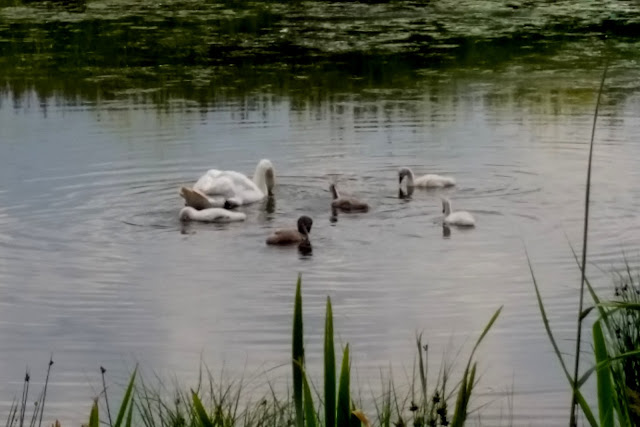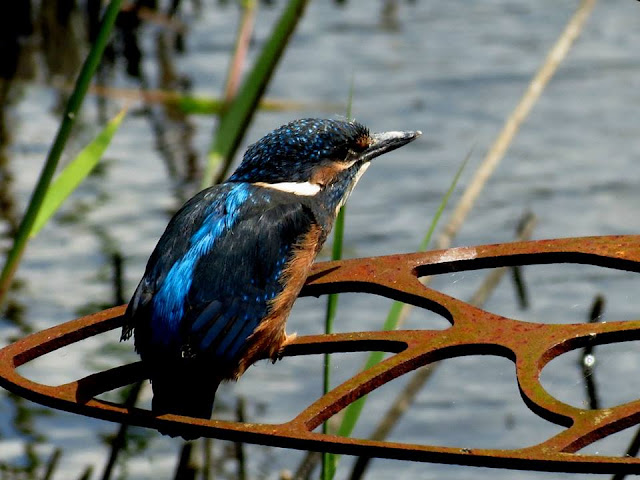A speedy circuit this morning to open up the hides but quite rewarding in the breezy conditions. It was already pretty warm and there was plenty of insect activity. Small Tortoiseshell butterflies were out egg laying on the Nettles and the first Meadow Brown of the year (for me) was flying strongly. Several large Tabanus autumnalis horseflies were prowling around the Adventure Playground, lounging on the fence rails waiting for an unsuspecting leg to pass by. They actually allow a close approach and are fairly fearless and this gives you a chance to get up close to those amazing eyes!
 |
| Female Tabanus autumnalis - eyes apart |
 |
| Male Tabanus autumnalis - eyes touching |
A few early morning flies were up in the Cordite with plenty of Tropida scita and Parhelophilus hoverflies. A picture taken yesterday of one of the latter by Steve Young may actually have enough on it identify it as P.versicolor which would be a step forward.
 |
| Parhelophilus versicolor - I hope - no little hairy protrusion on the underside of the femur |
Speckled Woods were dancing and there were several Dark and Speckled Bush Cricket nymphs catching some rays. Four-spot Chasers were active and Holy Blues were also still on the wing.
The Northern Trail was alive with calling Reed and Cetti’s Warblers and Reed Buntings were in song at several points. The pools were quiet but I did see the Mute Swan family at the west end. They still have five cygnets, which include three white Polish youngsters. They normally have a single in their brood. Let’s hope all five do well. A Redshank on one leg dissed me from one of the leaning rails and I could see well grown young opposite.
 |
| Not a great shot but you can see the two different cygnet colours... |
The male Marsh Harrier came down off the landfill with prey and a Hobby hurtled through at great speed after something only he could see and we still have hopes that the Harrier pair are working on a new family at the moment. The Target Pools are now dry and it will take a deluge of near Biblical proportions to re-wet this area, which is a pity but it has just been so dry this spring. It is a testament to the team here that we have water on other areas where the Lapwings and Redshanks are at their densest and, hopefully, we can keep things wet throughout the summer months and be just right for return autumn wader passage.
Down at the Dragonfly Pools there are now actually some dragonflies with Black-tailed Skimmers joining the Four Spot Chasers. Little Grebes were still feeding young on the Rudd fry in the shallows and at least eight well-grown young Bearded Tits were once again mucking about on their Dragonfly sculpture climbing frame. They are always such entertaining little birds – orange long-tailed tits with beady staring eyes and a fierce looking countenance. As I moved on, a group of fledged juvenile Lapwings came up off the Ouzel Fields and headed off to the river – another sign of success – and fine male Bearded Tit was collecting food opposite the Turnstile Bridge.
Packs of noisy Starlings were out foraging in the meadows and the local Little Egrets must have well grown young by now with the adults spending a lot of time here, catching tiddlers and froglets to feed their every growing offspring. A big dog Stoat appeared on the path in front of me with an adult Water Vole in its maw. He stopped, looked at me, dropped his prize and leapt into the grass. A quick look at his dinner revealed no signs of life so I walked on a few paces. It was my turn to stop and as I suspected Sid very quickly reappeared and grabbed his meal before bounding off. At least his effort and the sacrifice of the vole were not in vain. A quick pop into the MDZ revealed the male Kingfisher sitting on his favourite perch. Hopefully the female is still in the burrow on those new eggs and the whole Fisher Circus will start once again...
 |
| A youngster from the first brood... |
I spent some time today topping up our very dry bog garden and took the opportunity to sneak up on some of the smaller wildlife. The territorial male Wool Carder Bees were in fine fettle around the Mint and Horehound and even stopped occasionally for a rest in there diligent persuit of an insect no-fly zone.
 | |
| Wool Carder Bee - Anthidium manicatum - you can just about make out the tiny spurs on his flanks that he uses to 'bump' other bees and rivals out of the way with! |
 |
| The Herb Garden |
Three Red-headed Cardinals were seen along with Early Bumblebees (Bombus pratorum) and several other solitary bees while a Greenbottle allowed a close approach. Another fly had me stumped but both Annie and Phil have got us heading in the right direction with species of Chrysophilus.
 |
| Chrysopilus sp. (Rhagionidae). Probably C. cristatus |
 |
| Greenbottle - Lucilia sericata |
 |
| Red-headed Cardinal - Pyrochroa serraticornis |
 | |
| Lavender and Spit |



No comments:
Post a Comment